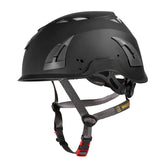Yes, you’ve guessed it. Roofs are one of the most dangerous places to work on-site.
The latest figures from the Health and Safety Executive (HSE) confirm almost one in five deaths in the construction sector occur as a consequence of working on roofs[1]. Falling from roof edges and openings, or through fragile roofs and rooflights, are the major offenders.
The figures also suggest many of those who end up suffering serious injuries are repairing or cleaning roofs without the basic training needed to work at height safely.
Whilst tragic, this does highlight an opportunity for a safer future. Many of those accidents can be avoided going forward if, as an industry, we deliver more education around the risks of working on roofs, and advise the necessary steps to mitigate them. Perhaps this will encourage more workers to deploy roofing safety best practices and equipment to keep them safe.
In this guide, we discuss some of the hazards that may present themselves when working on a roof, and the actions we can all take to reduce fatalities and safeguard our teams.
What are the roofing hazards?
Simply put, roofs are not designed for standing on.
But sometimes, it is necessary to do so.
Whether it’s safety inspections or important repair and renovation work, we often have to venture onto the roof to perform a task. And every time we do, we’re putting ourselves at risk. A large number of roofing accidents occur following trips or falls from height. It’s imperative we all understand the threats posed before undergoing any project.
Fragile roofs
The first hazard is the roof itself. According to HSE:
‘All roofs should be treated as fragile until a competent person has confirmed they are not. Do not trust any sheeting roof, whatever the material, to bear the weight of a person. This includes roof ridges and purlins.’
So, first things first. Don’t step on a roof until you’re confident it is safe to do so.
Skylights
Skylights are great at providing natural light. But one wrong move and they could let something else in, with devastating consequences.
If roof work is taking place near a skylight, it’s important to either restrict access to the location, or lessen the impact of a fall by deploying roofing safety equipment, such as safety harnesses and lanyards.
Steep slopes
If you’re operating on a roof with a steep slope or high pitch, you could easily slip and fall off the edge if you lose your footing. Measures must be put in place to both prevent a fall, and stop somebody tumbling over an edge if a fall does occur.
No edge protection
When you’re concentrating hard on the task at hand, you may lose track of your proximity to the edge of a roof. Without any preventative measures in place, a fall could easily take place.
How to work on a roof safely

There are many measures you can deploy to safeguard you and your team. Common sense should always prevail.
Trust your instincts. If something doesn’t feel safe, thoroughly consider the safety implications of what you’re about to do and only step onto the roof once you are confident you can do so safely. Carelessness kills. Take care in every step you take.
Conduct a full and thorough risk assessment
Critical to everyone’s safety when working at height is understanding the risks you might face in certain scenarios. Identifying the hazards on a roof will help you determine what type of protection you need. A full and thorough risk assessment will help you define all the potential hazards before you step onto a roof. This should include (but not be limited to):
- Adverse weather conditions
- Hazardous substances such as asbestos
- Access requirements and ladder safety
- The roof height
- Potential fall hazards
- Roof skylights
- The slope of the roof
- Worker knowledge gaps – is everyone confident to operate on a roof safely?
- Is your height safety equipment in tip top shape?
Follow HSE guidelines
Arming yourself with the understanding of what is safe and what is not cannot be underestimated. Having a clear grasp of the rules and regulations when working at height won’t just keep your team safe, but will prevent the risks of company fines if an accident does take place.
Check the weather forecast
Slips, trips and falls are a common cause of workplace injuries and can often result in falls from height, especially on roofs. Practice caution and if there’s some bad weather on the way. Avoid roof work for the time being. Adverse weather such as high winds, heavy rain and ice are particular hazards.
Never let an impending deadline impact worker safety. If possible, it’s always best to avoid poor weather.
Follow safety policies and procedures
Another tried and tested method to help eliminate rooftop accidents is to implement stringent safety procedure guidelines. It should be mandatory to implement and follow such best practices. This will protect employees from harm and ensure anybody who accesses a roof to perform a task is suitably protected.
Wear appropriate clothes and PPE
Whether you’re working on a roof or conducting any other work at height, it’s important you’re wearing the right clothes and personal protective equipment (PPE).
In terms of clothing, we recommend wearing something comfortable that will enable you to move your body freely. But not too loose that it could create a trip or fall hazard.
The right footwear is important too. A rubber-soled shoe will help you achieve maximum grip and traction to prevent slips.
PPE will, of course, be imperative in any scenario when working at height. From height safety helmets to safety harness and fall restraint lanyards, equipping yourself with high-quality PPE is a proven way to ensure you can conduct your work safely.
Deploy best-in-class height safety equipment
As well as taking advantage of innovative PPE, specialist height safety equipment will help you implement your new safety procedures and policies. For example, the BIGBEN® Mobile Man Anchor can be used on flat roofs to provide an anchor point for workers at height. Used in conjunction with a height safety harness and fall restraint lanyard, this will ensure workers are unable to access high risk areas where a fall could take place.

If working on the edge of a roof, you should use a fall arrest block to halt a fall in its tracks.
Keep a clean and tidy work area
Ensuring your work area is clean and tidy will reduce potential trip hazards. It’s a simple undertaking to clean up as you go, and it could make all the difference and prevent a fall from a rooftop.
Don’t be a statistic – protect your team with roofing safety equipment from Leach’s
We all know that working at height, especially on roofs, presents a very real threat. We must understand what those dangers are in order to effectively mitigate against them.
Businesses that excel at implementing stringent safety measures when working on roofs, and who choose the most appropriate fall protection equipment, will be successful in reducing the risk of injuries to workers. Explore Leach’s range of roofing safety equipment now, or contact our sales team on 01432 346890 for further guidance.
*This is not a complete guide. We always recommend speaking to a competent and trained height safety specialist before undertaking any work at height.
[1]https://www.hse.gov.uk/construction/safetytopics/roofwork.htm


















